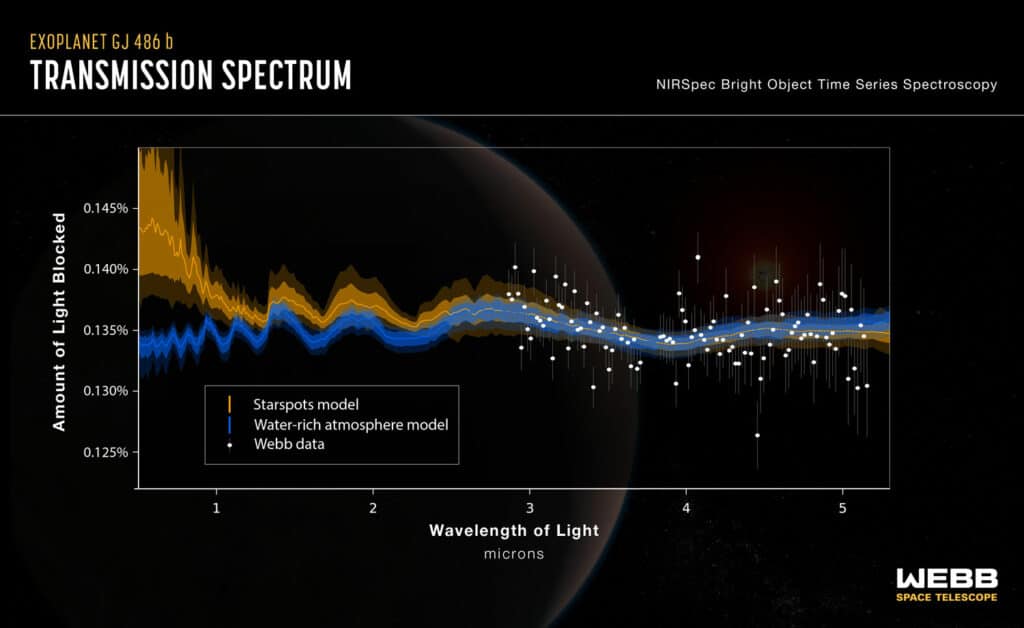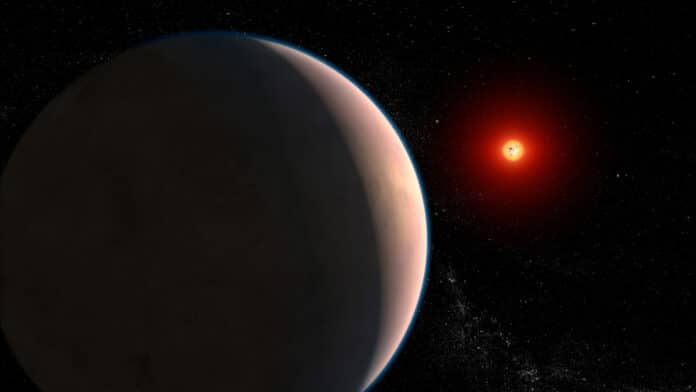While studying a rocky exoplanet known as GJ 486 b, NASA‘s James Webb Space Telescope- using its Webb’s Near-Infrared Spectrograph (NIRSpec)- detected signals of water vapor. GJ 486 b is too close to its star to be within the habitable zone, with a surface temperature of about 800 degrees Fahrenheit (430 degrees Celsius).
Despite its extreme heat and proximity to its star, the presence of water vapor would suggest that it possesses an atmosphere. However, the team cautions that the water vapor may not even be coming from the planet and instead be present on the star, precisely in cool starspots.
Sarah Moran of the University of Arizona in Tucson, lead author of the study, said, “We see a signal, and it’s almost certainly due to water. But we can’t tell yet if that water is part of the planet’s atmosphere, meaning the planet has an atmosphere, or if we’re seeing a water signature coming from the star.”
The planet GJ 486 b is about 30% larger than Earth. It is three times as massive with stronger gravity than Earth. It completes its orbit around a red dwarf star in under 1.5 Earth days.
From the vantage point, GJ 486 b transits its star, passing before it. If it has an atmosphere, starlight will pass through those gases as it passes in front of it during transit, leaving fingerprints in the light that would enable astronomers to determine its composition using a method known as transmission spectroscopy.

The team observed two transits, each lasting for nearly an hour. They then examined the obtained data using three distinct techniques. All three sets of results exhibit a mostly flat spectrum with an intriguing peak at the shortest infrared wavelengths. The scientists used computer simulations to investigate a variety of molecules and concluded that the most likely source of the signal was water vapor.
While the water vapor might suggest that GJ 486 b has an atmosphere, water vapor from the star is also a likely explanation. Surprisingly, water vapor can occasionally be found in sunspots on our own Sun since they are extremely chilly compared to the star’s surrounding surface. Because the host star of GJ 486 b is much more relaxed than the Sun, its starspots would condense even more water vapor. It could therefore provide a signal that resembles a planetary atmosphere.
Ryan MacDonald of the University of Michigan in Ann Arbor, one of the study’s co-authors, said, “We didn’t observe evidence of the planet crossing any starspots during the transits. But that doesn’t mean there aren’t spots elsewhere on the star. And that’s exactly the physical scenario that would imprint this water signal into the data and could wind up looking like a planetary atmosphere.”
Scientists noted, “Future Webb observations may shed more light on this system. An upcoming Webb program will use the Mid-Infrared Instrument (MIRI) to observe the planet’s day side. If the planet has no atmosphere or only a thin atmosphere, then the hottest part of the day side is expected to be directly under the star. However, if the hottest point is shifted, that would indicate an atmosphere that can circulate heat.”
“Ultimately, observations at shorter infrared wavelengths by another Webb instrument, the Near-Infrared Imager and Slitless Spectrograph (NIRISS), will be needed to differentiate between the planetary atmosphere and starspot scenarios.”
Stevenson said, “It’s joining multiple instruments together that will pin down whether or not this planet has an atmosphere.”
Journal Reference:
- Sarah Moran, Kevin Stevenson, et al. High Tide or Rip-Tide on the Cosmic Shoreline? A Water-Rich Atmosphere or Stellar Contamination for the Warm Super-Earth GJ 486b from JWST Observations. The Astrophysical Journal Letters. Preprint.
